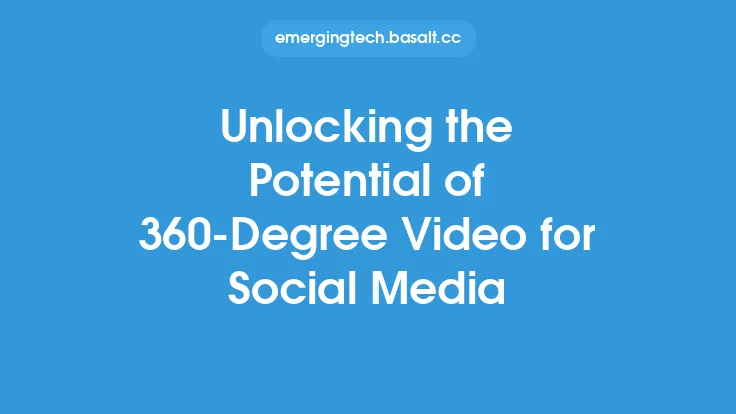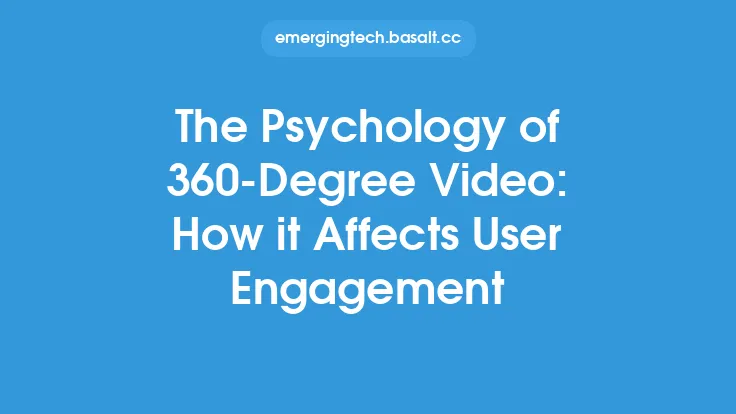The entertainment industry has undergone a significant transformation with the advent of 360-degree video technology. This immersive medium has opened up new avenues for content creators to engage audiences and provide an unparalleled viewing experience. 360-degree video, also known as spherical video, is a type of video recording that captures a 360-degree view of a scene, allowing viewers to see the action from all angles. This technology has been gaining traction in recent years, and its impact on the entertainment industry is multifaceted.
Introduction to 360-Degree Video Technology
360-degree video technology uses a combination of cameras, software, and hardware to capture and display panoramic footage. The recording process typically involves using multiple cameras, often mounted on a rig, to capture a 360-degree view of a scene. The footage is then stitched together using specialized software to create a seamless, spherical video. This video can be displayed on a variety of devices, including virtual reality (VR) headsets, smartphones, and computers. The technical aspects of 360-degree video production involve understanding concepts such as equirectangular projection, which is a method of mapping a 360-degree image onto a 2D surface, and ambisonic audio, which is a technique for recording and playing back 3D audio.
Impact on Film and Television Production
The introduction of 360-degree video technology has revolutionized the way films and television shows are produced. Content creators can now experiment with new formats, such as interactive stories and immersive experiences, which were previously not possible with traditional video technology. 360-degree video allows filmmakers to put the viewer in the midst of the action, creating a more engaging and interactive experience. This technology has also enabled the creation of new types of content, such as virtual reality experiences and 360-degree live streams. For instance, the use of 360-degree video in film production involves techniques such as camera rigging, where multiple cameras are mounted on a rig to capture a 360-degree view of a scene, and camera tracking, where the movement of the camera is tracked to ensure a smooth and seamless viewing experience.
Virtual Reality and 360-Degree Video
Virtual reality (VR) and 360-degree video are closely related technologies that are often used together to create immersive experiences. VR headsets, such as Oculus Rift and HTC Vive, are designed to display 360-degree video content, providing a fully immersive experience for the viewer. The combination of VR and 360-degree video has enabled the creation of new types of entertainment content, such as interactive stories and immersive games. The technical aspects of VR and 360-degree video involve understanding concepts such as field of view, which refers to the extent of the scene that is visible to the viewer, and latency, which refers to the delay between the viewer's head movement and the corresponding change in the video image.
Live Events and 360-Degree Video
360-degree video technology has also had a significant impact on the way live events are experienced. Concerts, sports events, and other live performances can now be streamed in 360-degree video, allowing viewers to feel as though they are part of the action. This technology has also enabled the creation of new types of live events, such as virtual concerts and 360-degree live streams. The use of 360-degree video in live events involves techniques such as live stitching, where the footage from multiple cameras is stitched together in real-time to create a seamless 360-degree video, and live streaming, where the 360-degree video is transmitted over the internet in real-time.
Challenges and Limitations
While 360-degree video technology has opened up new avenues for content creators, it also presents several challenges and limitations. One of the main challenges is the high cost of production, which can make it difficult for smaller production companies to create 360-degree video content. Additionally, the technical requirements for 360-degree video production, such as high-resolution cameras and powerful computers, can be daunting for those who are new to the technology. The limitations of 360-degree video technology include the limited field of view, which can make it difficult to capture a wide scene, and the high latency, which can cause a delay between the viewer's head movement and the corresponding change in the video image.
Future of 360-Degree Video in Entertainment
Despite the challenges and limitations, the future of 360-degree video in the entertainment industry looks promising. As the technology continues to evolve and improve, we can expect to see more innovative and interactive content being created. The increasing adoption of VR headsets and other devices capable of displaying 360-degree video content will also drive the growth of this technology. Furthermore, the development of new technologies, such as augmented reality (AR) and mixed reality (MR), will likely have a significant impact on the entertainment industry, enabling the creation of even more immersive and interactive experiences. The future of 360-degree video in entertainment will involve the use of advanced technologies such as artificial intelligence (AI) and machine learning (ML) to create more personalized and interactive experiences for the viewer.
Conclusion
In conclusion, 360-degree video technology has had a significant impact on the entertainment industry, enabling the creation of new types of content and immersive experiences. While there are challenges and limitations to this technology, its potential for growth and innovation is vast. As the technology continues to evolve and improve, we can expect to see more innovative and interactive content being created, and the entertainment industry will likely be transformed forever. The use of 360-degree video technology will continue to play a major role in the entertainment industry, enabling the creation of more immersive and interactive experiences for the viewer.





